Gudermannian function
In mathematics, the Gudermannian function relates a hyperbolic angle measure to a circular angle measure called the gudermannian of and denoted .[1] The Gudermannian function reveals a close relationship between the circular functions and hyperbolic functions. It was introduced in the 1760s by Johann Heinrich Lambert, and later named for Christoph Gudermann who also described the relationship between circular and hyperbolic functions in 1830.[2] The gudermannian is sometimes called the hyperbolic amplitude as a limiting case of the Jacobi elliptic amplitude when parameter
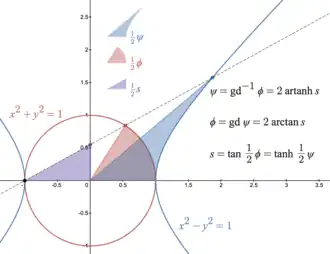
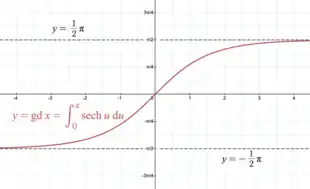

The real Gudermannian function is typically defined for to be the integral of the hyperbolic secant[3]
The real inverse Gudermannian function can be defined for as the integral of the secant
The hyperbolic angle measure is called the anti-gudermannian of or sometimes the lambertian of , denoted [4] In the context of geodesy and navigation for latitude , (scaled by arbitrary constant ) was historically called the meridional part of (French: latitude croissante). It is the vertical coordinate of the Mercator projection.
The two angle measures and are related by a common stereographic projection
and this identity can serve as an alternative definition for and valid throughout the complex plane:
Circular–hyperbolic identities
We can evaluate the integral of the hyperbolic secant using the stereographic projection (hyperbolic half-tangent) as a change of variables:[5]
Letting and we can derive a number of identities between hyperbolic functions of and circular functions of [6]
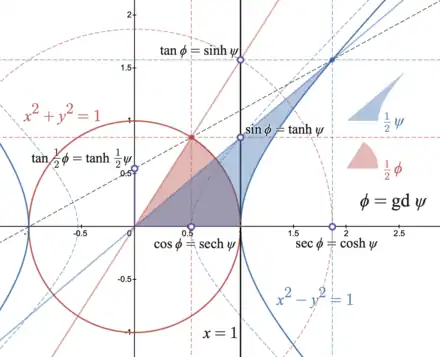
These are commonly used as expressions for and for real values of and with For example, the numerically well-behaved formulas
(Note, for and for complex arguments, care must be taken choosing branches of the inverse functions.)[7]
We can also express and in terms of
If we expand and in terms of the exponential, then we can see that and are all Möbius transformations of each-other (specifically, rotations of the Riemann sphere):
For real values of and with , these Möbius transformations can be written in terms of trigonometric functions in several ways,
These give further expressions for and for real arguments with For example,[8]
Complex values
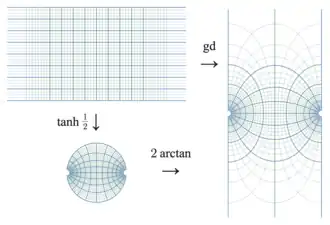
As a functions of a complex variable, conformally maps the infinite strip to the infinite strip while conformally maps the infinite strip to the infinite strip
Analytically continued by reflections to the whole complex plane, is a periodic function of period which sends any infinite strip of "height" onto the strip Likewise, extended to the whole complex plane, is a periodic function of period which sends any infinite strip of "width" onto the strip [9] For all points in the complex plane, these functions can be correctly written as:
For the and functions to remain invertible with these extended domains, we might consider each to be a multivalued function (perhaps and , with and the principal branch) or consider their domains and codomains as Riemann surfaces.
If then the real and imaginary components and can be found by:[10]
(In practical implementation, make sure to use the 2-argument arctangent, .)
Likewise, if then components and can be found by:[11]
Multiplying these together reveals the additional identity[8]
Symmetries
The two functions can be thought of as rotations or reflections of each-other, with a similar relationship as between sine and hyperbolic sine:[12]
The functions are both odd and they commute with complex conjugation. That is, a reflection across the real or imaginary axis in the domain results in the same reflection in the codomain:
The functions are periodic, with periods and :
A translation in the domain of by results in a half-turn rotation and translation in the codomain by one of and vice versa for [13]
A reflection in the domain of across either of the lines results in a reflection in the codomain across one of the lines and vice versa for
This is related to the identity
Specific values
A few specific values (where indicates the limit at one end of the infinite strip):[14]
Derivatives
Argument-addition identities
By combining hyperbolic and circular argument-addition identities,
with the circular–hyperbolic identity,
we have the Gudermannian argument-addition identities:
Further argument-addition identities can be written in terms of other circular functions,[15] but they require greater care in choosing branches in inverse functions. Notably,
which can be used to derive the per-component computation for the complex Gudermannian and inverse Gudermannian.[16]
In the specific case double-argument identities are
Taylor series
The Taylor series near zero, valid for complex values with are[17]
where the numbers are the Euler secant numbers, 1, 0, -1, 0, 5, 0, -61, 0, 1385 ... (sequences A122045, A000364, and A028296 in the OEIS). These series were first computed by James Gregory in 1671.[18]
Because the Gudermannian and inverse Gudermannian functions are the integrals of the hyperbolic secant and secant functions, the numerators and are same as the numerators of the Taylor series for sech and sec, respectively, but shifted by one place.
The reduced unsigned numerators are 1, 1, 1, 61, 277, ... and the reduced denominators are 1, 6, 24, 5040, 72576, ... (sequences A091912 and A136606 in the OEIS).
History
The function and its inverse are related to the Mercator projection. The vertical coordinate in the Mercator projection is called isometric latitude, and is often denoted In terms of latitude on the sphere (expressed in radians) the isometric latitude can be written
The inverse from the isometric latitude to spherical latitude is (Note: on an ellipsoid of revolution, the relation between geodetic latitude and isometric latitude is slightly more complicated.)
Gerardus Mercator plotted his celebrated map in 1569, but the precise method of construction was not revealed. In 1599, Edward Wright described a method for constructing a Mercator projection numerically from trigonometric tables, but did not produce a closed formula. The closed formula was published in 1668 by James Gregory.
The Gudermannian function per se was introduced by Johann Heinrich Lambert in the 1760s at the same time as the hyperbolic functions. He called it the "transcendent angle", and it went by various names until 1862 when Arthur Cayley suggested it be given its current name as a tribute to Christoph Gudermann's work in the 1830s on the theory of special functions.[19] Gudermann had published articles in Crelle's Journal that were later collected in a book[20] which expounded and to a wide audience (although represented by the symbols and ).
The notation was introduced by Cayley who starts by calling the Jacobi elliptic amplitude in the degenerate case where the elliptic modulus is so that reduces to [21] This is the inverse of the integral of the secant function. Using Cayley's notation,
He then derives "the definition of the transcendent",
observing that "although exhibited in an imaginary form, [it] is a real function of ".
The Gudermannian and its inverse were used to make trigonometric tables of circular functions also function as tables of hyperbolic functions. Given a hyperbolic angle , hyperbolic functions could be found by first looking up in a Gudermannian table and then looking up the appropriate circular function of , or by directly locating in an auxiliary column of the trigonometric table.[22]
Generalization
The Gudermannian function can be thought of mapping points on one branch of a hyperbola to points on a semicircle. Points on one sheet of an n-dimensional hyperboloid of two sheets can be likewise mapped onto a n-dimensional hemisphere via stereographic projection. The hemisphere model of hyperbolic space uses such a map to represent hyperbolic space.
Applications
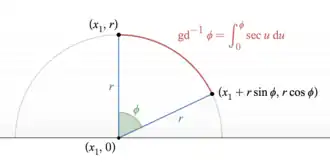
- The angle of parallelism function in hyperbolic geometry is the complement of the gudermannian,
- On a Mercator projection a line of constant latitude is parallel to the equator (on the projection) and is displaced by an amount proportional to the inverse Gudermannian of the latitude.
- The Gudermannian (with a complex argument) may be used to define the transverse Mercator projection.[23]
- The Gudermannian appears in a non-periodic solution of the inverted pendulum.[24]
- The Gudermannian appears in a moving mirror solution of the dynamical Casimir effect.[25]
- If an infinite number of infinitely long, equidistant, parallel, coplanar, straight wires are kept at equal potentials with alternating signs, the potential-flux distribution in a cross-sectional plane perpendicular to the wires is the complex Gudermannian.[26]
- The Gudermannian function is a sigmoid function, and as such is sometimes used as an activation function in machine learning.
- The (scaled and shifted) Gudermannian is the cumulative distribution function of the hyperbolic secant distribution.
- A function based on the Gudermannian provides a good model for the shape of spiral galaxy arms.[27]
Notes
- The symbols and were chosen for this article because they are commonly used in geodesy for the isometric latitude (vertical coordinate of the Mercator projection) and geodetic latitude, respectively, and geodesy/cartography was the original context for the study of the Gudermannian and inverse Gudermannian functions.
- Gudermann published several papers about the trigonometric and hyperbolic functions in Crelle's Journal in 1830–1831. These were collected in a book, Gudermann (1833).
- Roy & Olver (2010) §4.23(viii) "Gudermannian Function"; Beyer (1987)
- Kennelly (1929); Lee (1976)
- Masson (2021)
- Gottschalk (2003) pp. 23–27
- Masson (2021) draws complex-valued plots of several of these, demonstrating that naïve implementations that choose the principal branch of inverse trigonometric functions yield incorrect results.
- Weisstein, Eric W. "Gudermannian". MathWorld.
- Kennelly (1929)
- Kennelly (1929) p. 181; Beyer (1987) p. 269
- Beyer (1987) p. 269 – note the typo.
- Legendre (1817) §4.2.8(163) pp. 144–145
- Kennelly (1929) p. 182
- Kahlig & Reich (2013)
- Cayley (1862) p. 21
- Kennelly (1929) pp. 180–183
- Legendre (1817) §4.2.7(162) pp. 143–144
- Turnbull, Herbert Westren, ed. (1939). James Gregory; Tercentenary Memorial Volume. G. Bell & Sons. p. 170.
- Becker & Van Orstrand (1909)
- Gudermann (1833)
- Cayley (1862)
- For example Hoüel labels the hyperbolic functions across the top in Table XIV of: Hoüel, Guillaume Jules (1885). Recueil de formules et de tables numériques. Gauthier-Villars. p. 36.
- Osborne (2013) p. 74
- Robertson (1997)
- Good, Anderson & Evans (2013)
- Kennelly (1928)
- Ringermacher & Mead (2009)
References
- Barnett, Janet Heine (2004). "Enter, Stage Center: The Early Drama of the Hyperbolic Functions" (PDF). Mathematics Magazine. 77 (1): 15–30. doi:10.1080/0025570X.2004.11953223.
- Becker, George Ferdinand; Van Orstrand, Charles Edwin (1909). Hyperbolic Functions. Smithsonian Mathematical Tables. Smithsonian Institution.
- Becker, George Ferdinand (1912). "The gudermannian complement and imaginary geometry" (PDF). The London, Edinburgh, and Dublin Philosophical Magazine and Journal of Science. 24 (142): 600–608. doi:10.1080/14786441008637363.
- Beyer, William H., ed. (1987). CRC Handbook of Mathematical Sciences (6th ed.). CRC Press. pp. 268–286.
- Cayley, Arthur (1862). "On the transcendent ". Philosophical Magazine. 4th Series. 24 (158): 19–21. doi:10.1080/14786446208643307.
- Good, Michael R.R.; Anderson, Paul R.; Evans, Charles R. (2013). "Time dependence of particle creation from accelerating mirrors". Physical Review D. 88 (2): 025023. arXiv:1303.6756. doi:10.1103/PhysRevD.88.025023.
- Gottschalk, Walter (2003). "Good Things about the Gudermannian" (PDF). Gottschalk's Gestalts.
- Gudermann, Christoph (1833). Theorie der Potenzial- oder cyklisch-hyperbolischen Functionen [Theory of Potential- or Circular-Hyperbolic Functions] (in German). G. Reimer.
- Jennings, George; Ni, David; Pong, Wai Yan; Raianu, Serban (2022). "The Integral of Secant and Stereographic Projections of Conic Sections". arXiv:2204.11187 [math.HO].
- Kahlig, Peter; Reich, Ludwig (2013). Contributions to the theory of the Legendre-Gudermann equation (PDF) (Technical report). Fachbibliothek für Mathematik, Karl-Franzens-Universität Graz.
- Karney, Charles F.F. (2011). "Transverse Mercator with an accuracy of a few nanometers". Journal of Geodesy. 85 (8): 475–485. arXiv:1002.1417. doi:10.1007/s00190-011-0445-3.
- Kennelly, Arthur E. (1928). "Gudermannian Complex Angles". Proceedings of the National Academy of Sciences. 14 (11): 839–844. doi:10.1073/pnas.14.11.839.
- Kennelly, Arthur E. (1929). "Gudermannians and Lambertians with Their Respective Addition Theorems". Proceedings of the American Philosophical Society. 68 (3): 175–184.
- Lambert, Johann Heinrich (1761). "Mémoire sur quelques propriétés remarquables des quantités transcendentes circulaires et logarithmiques" [Memoir on some remarkable properties of the circular and logarithmic transcendental quantities]. Histoire de l'Académie Royale des Sciences et des Belles-Lettres (in French). Berlin (published 1768). 17: 265–322.
- Lee, Laurence Patrick (1976). Conformal Projections Based on Elliptic Functions. Cartographica Monograph. Vol. 16. University of Toronto Press.
- Legendre, Adrien-Marie (1817). Exercices de calcul intégral [Exercises in integral calculus] (in French). Vol. 2. Courcier.
- Majernik, V. (1986). "Representation of relativistic quantities by trigonometric functions". American Journal of Physics. 54 (6): 536–538. doi:10.1119/1.14557.
- McMahon, James (1906). Hyperbolic Functions. Wiley. [First published as McMahon (1896). "IV. Hyperbolic Functions". In Merriman; Woodward (eds.). Higher Mathematics. Wiley. pp. 107–168.]
- Masson, Paul (2021). "The Complex Gudermannian". Analytic Physics.
- Osborne, Peter (2013). "The Mercator projections" (PDF).
- Peters, J. M. H. (1984). "The Gudermannian". The Mathematical Gazette. 68 (445): 192–196. doi:10.2307/3616342. JSTOR 3616342.
- Reynolds, William F. (1993). "Hyperbolic Geometry on a Hyperboloid" (PDF). The American Mathematical Monthly. 100 (5): 442–455. doi:10.1080/00029890.1993.11990430. Archived from the original (PDF) on 2016-05-28.
- Rickey, V. Frederick; Tuchinsky, Philip M. (1980). "An application of geography to mathematics: History of the integral of the secant" (PDF). Mathematics Magazine. 53 (3): 162–166. doi:10.1080/0025570X.1980.11976846.
- Ringermacher, Harry I.; Mead, Lawrence R. (2009). "A new formula describing the scaffold structure of spiral galaxies". Monthly Notices of the Royal Astronomical Society. 397 (1): 164–171. doi:10.1111/j.1365-2966.2009.14950.x.
- Robertson, John S. (1997). "Gudermann and the simple pendulum". The College Mathematics Journal. 28 (4): 271–276. doi:10.2307/2687148. JSTOR 2687148.
- Romakina, Lyudmila N. (2018). "The inverse Gudermannian in the hyperbolic geometry". Integral Transforms and Special Functions. 29 (5): 384–401. doi:10.1080/10652469.2018.1441296.
- Roy, Ranjan; Olver, Frank W. J. (2010), "4. Elementary Functions", in Olver, Frank W. J.; et al. (eds.), NIST Handbook of Mathematical Functions, Cambridge University Press, ISBN 978-0-521-19225-5, MR 2723248.
- Sala, Kenneth L. (1989). "Transformations of the Jacobian amplitude function and its calculation via the arithmetic-geometric mean" (PDF). SIAM Journal on Mathematical Analysis. 20 (6): 1514–1528. doi:10.1137/0520100.